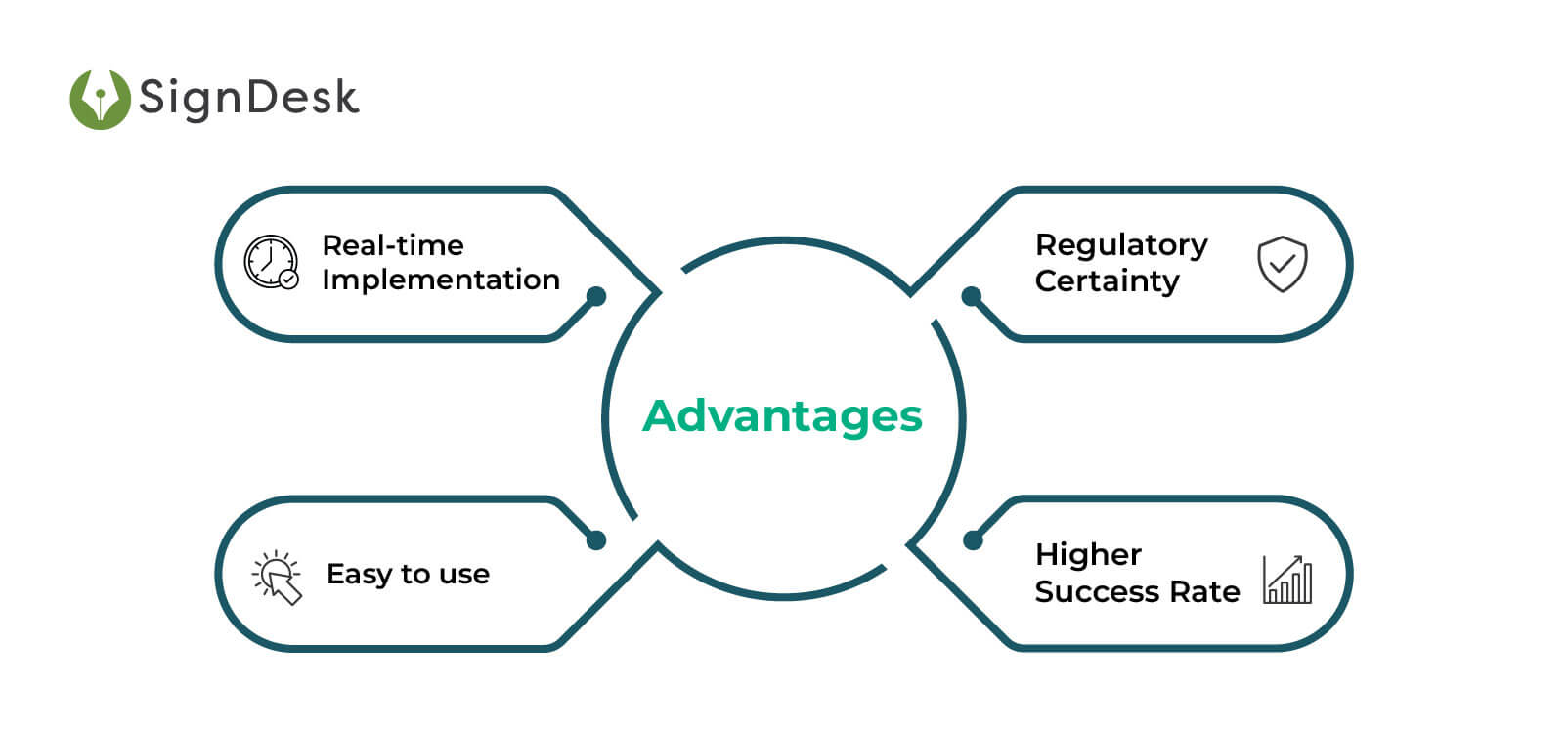What is an API Mandate?
An application-programming interface (API) is a set of standards and programming guidelines for accessing a web-based software programme or web utility, allowing two apps to connect with one another. Through the development of cloud-native applications, it is easy to access one’s exclusive instrument. Additionally, sharing data with clients and people outside of the domain is helpful.
An API mandate in this situation refers to Standing Instructions (SIs) submitted using an API for with the aid of an e mandate service provider. API e mandates allow businesses to collect any mandate-related data & transmit this information to the NPCI and then the destination bank from which amounts are debited.
In order to register e mandates, customers simply visit the company’s website, preview & verify their mandate details on the NPCI interface, and verifying these details using either internet banking credentials or debit card credentials.
NPCI further emphasises that the customer is responsible for verifying the authenticity of all the mandate data they are ready to authenticate using the eMandate APIs. The consumer must select the authentication technique and approve the mandate using his or her information after giving consent in this regard.
API e mandates are provided by recurring payments service providers such as SignDesk
In a nutshell, here’s how to register mandates using an API e mandate:
-
- The corporate organization makes an eMandate request
-
- Signdesk’s collects the required information, which is then communicated with the NPCI – ONMAGS page
- The customer is invited to view these details & subsequently forwarded to the target bank after consenting
- For verification, the customer enters their Netbanking or debit card information here
- The bank then accepts or rejects the e mandate
Why do businesses need API e-Mandates?
A business operates well only when the payments and transactions are done smoothly and without any failure. Although companies have long been able to collect recurring payments such as SIPs, insurance premiums, etc., the procedure was only approved when the end user filled out and signed a paper form. The entire procedure was made simpler by e-mandate and e-NACH.
API e mandate variants differ from other variants in that they can be registered in real-time. This means that businesses can use API mandates to streamline their payment workflows and reduce friction.

Here are a few other reasons why businesses might prefer API mandates.
- High Success Rates
API e mandates have a success rate of 70-80%, the highest among all mandate variants. Businesses require mandates to go through successfully to ensure timely payment collection and API mandates ensure that mandate registration is consistent.
- Bulk Upload Options
Businesses can upload as many mandates as required using APIs. These mandates are all uploaded to NPCI in real-time and subsequently approved at once. This helps businesses streamline their payments and make operations smoother.
- Real-time Registration
As mentioned previously, API e mandates are registered instantly in real-time. Clients simply validate their NetBanking or Debit Card details to complete registration, enabling businesses to make the payment experience seamless.
- Easy Integration
Lightweight e mandate APIs are immensely convenient to use and even easier to integrate with. Businesses can begin using API mandates within days to automate recurring payments, without any third-party assistance.
Which Industry Segments Require API Mandates?
The businesses and industries that require quick & consistent e mandate registration are as follows:
- Banking and NBFCs:
The largest beneficiaries recurring payment automation via eNACH e-mandate are banks and NBFCs. The e mandate process has aided financial institutions in streamlining their payments and automating large numbers of recurrent debit transactions fast, allowing for easy loan EMI payments and improved credit access.
For loan EMI repayments, banks can create several e-mandates, track and manage these mandates online, and guarantee on-time payments.
- Insurance Services:
At insurance firms, payments are made on a daily and even hourly basis for a variety of life, health, vehicle, and travel insurance products. These policy payments are automated and routinely made with the aid of e-mandates to guarantee the stability of the policy.
Insurers can easily collect policy payments when policyholders confirm these e-mandates using their NetBanking credentials or Aadhaar information.
- Mutual Funds:
For mutual fund sellers and distributors, the e mandate process reduces the need for manual document processing, improving overall business efficiency. Collaboration during corporate audits is facilitated by the creation of a virtual audit trail for investment activities through eNACH-based payments automation.
- Healthcare Sector:
By adopting smart e mandate process, healthcare providers can automate EMI payments for medical insurance and medical equipment/treatment in monthly instalments.
- OTT Platforms:
For a subscription-based website, collecting recurring payments for subscriptions is a laborious and time-consuming procedure that is unavoidable. Adding an automated subscription payment system gives both the customer and the OTT service provider peace of mind.
- Education Sector:
The schools and the various educational institutions can get rid of the burden of several courses and the collecting of their fees by implementing automated mandate regulations.
- Non-Governmental Organizations(NGOs):
E-mandates have been adopted by a number of NGOs to simplify the donation procedure. With e-mandates, NGOs can automate donation collection by letting the system periodically deduct funds from donors’ accounts.
This saves valuable the time and resources that NGOs require to increase their donors, monitor payments, and make sure that donations have a robust audit trail.
How Does an API Mandate Work?
When the customer submits mandate approval using their banking credentials, the API Mandate functions. The process is carried out in the following way:
-
- The corporate organization first sends an e mandate request to SignDesk who collect all the required mandate information.
- The client connects into the business’ website to view the specifics of the mandate.
- The customer must input their bank account number if they decide to accept the requirement. The business might additionally give customers the choice of bank account and authentication method. The business must make sure that the mentioned banks are ONMAGS registered with the NPCI.
- The customer is then taken to the NPCI page, where they can select Netbanking or Debit card authentication as their method of authentication.
- Following the choice, the NPCI ONMAGS interface will display a list of banks that have registered for the chosen authentication mechanism. The option will be pre-filled if the consumer has already selected it on the business website.
- The customer is subsequently forwarded to the relevant bank’s authentication page, where they can use the earlier-chosen alternative to authenticate the mandate.
- The bank verifies that the account number provided on the website of the company corresponds to the account number used by the user to authenticate the login.
- The customer then has the choice to accept or reject the mandate once the bank has displayed a summary of it.
- After making a choice, the customer will be taken back to the NPCI ONMAGS interface and then to the business’ website, where the approval status of the Mandate will be shown.
An API mandate is executed in this manner. The NPCI further emphasises that the customer is responsible for verifying the authenticity of all the mandate data they are ready to authenticate using the eMandate APIs. The consumer must select the authentication technique and approve the mandate using his or her information after giving consent in this regard.
The Advantages of API Mandates
The API Mandate has certain advantages that gives it an upper hand over the other forms of e-Mandate. It can be understood in the following way:
- Real-time Implementation
The API mandates get registered and activated in real time unlike the Aadhaar eSign or physical mandates which take at least 2-3 or more days to complete.
- Easy to use
The customer simply needs to log in with their Netbanking credentials to authorise an API mandate. The customer must make sure that their cellphone number is connected to their Aadhaar in order to participate in the Aadhaar-based eMandate. This choice was ruled invalid by the most recent decision.
- Regulatory Certainty
The API mandate has less regulatory uncertainty than the depreciating Aadhaar-based eMandate.
- Higher Success Rate
The success rate of using API mandate has been as high as 95% which is much greater when compared to its physical and Aadhaar eSign variants.
The API mandate can be concluded as the best way to carry out the process of registration of mandate. Companies can use the API-based e-Mandate rather than returning to the manual procedure of obtaining mandates approved because there are no regulatory problems.
Link.It: The API e-Mandate Solution
Link. It by SignDesk provides an eNACH eMandate solution for quickly automating recurring payments that complies with NPCI. Our technology controls recurring payments by allowing the customer’s bank to regularly debit accounts from over a thousand different banks.
Customers can set up recurring auto-debit transactions for your business as well as quickly validate API mandates like NetBanking or debit/credit card credentials with SignDesk’s e-Mandate solution.
SignDesk’s eMandate solutions are used by a number of large banks and financial institutions to cut expenses by 60 to 85% and turnaround time by more than 50%.
